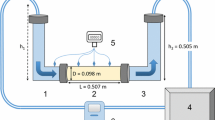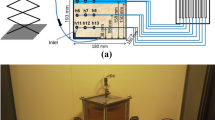Abstract
Experiments on 220, 320 and 500-grit sandpaper surfaces were conducted in a high Reynolds number turbulent channel flow facility with an 8:1 aspect ratio. Pressure drop measurements in the fully developed region yielded the skin-friction curves for Reynolds number based on the bulk mean velocity (Rem) up to 2.5 × 105. Detailed velocity profiles were also obtained for the 320-grit sandpaper at friction Reynolds number (Reτ) from 1000 to 6000 using laser Doppler velocimetry (LDV). The skin-friction curves and roughness functions for the sandpaper surfaces show many similarities to and some differences from uniform sand roughness. The most notable difference is that the equivalent sand roughness height (ks) for the sandpaper is several times larger than its median grit size. Possible reasons for this disparity are discussed. Mean flow and turbulence results on 320-grit sandpaper indicate similarity between the rough and smooth walls in the outer layer (y/h > 0.15). ks for each sandpaper studied is compared to predicted results from existing empirical correlations based on statistics of the surface texture. A correlation for ks based on the rms roughness height (krms) and the skewness of the surface elevation probability density function (Sk) shows the most promise.











Similar content being viewed by others
Data availability
The data in this paper will be available at http://roughnessdatabase.org.
Abbreviations
- A :
-
Log-law intercept for a smooth wall = 4.27
- B s :
-
Log-law constant for a rough wall
- B s(∞):
-
Log-law constant for a fully rough wall = 8.5
- C f :
-
Skin-friction coefficient \(= \tau_{w} {/}(1{/}2\rho \overline{U}^{2} )\)
- d :
-
LDV probe volume diameter
- dp/dx :
-
Streamwise pressure gradient
- ES:
-
Effective slope = \(1{/}L_{s} \int {|\partial h^{\prime } {/}\partial x|} \partial x\)
- Fl:
-
Flatness = \(1{/}N\sum\nolimits_{i = 1}^{N} {h_{i}^{\prime 4} } /\left[ {1{/}N\sum\nolimits_{i = 1}^{N} {h_{i}^{\prime 2} } } \right]^{2}\)
- h :
-
Channel half-height = H/2
- \(\overline{h}\) :
-
Mean roughness elevation
- \(h^{\prime }\) :
-
Variation in roughness elevation about the mean
- H :
-
Channel height
- k :
-
Roughness height
- k a :
-
Centerline average roughness height = \({1 \mathord{\left/ {\vphantom {1 N}} \right. \kern-\nulldelimiterspace} N}\sum\nolimits_{i = 1}^{N} {h_{i}^{\prime } }\)
- k p :
-
Elevation of a roughness peak
- k rms :
-
Root-mean-square roughness height = \(\sqrt {{1 \mathord{\left/ {\vphantom {1 {N\sum\nolimits_{i = 1}^{N} {h_{i}^{\prime 2} } }}} \right. \kern-\nulldelimiterspace} {N\sum\nolimits_{i = 1}^{N} {h_{i}^{\prime 2} } }}}\)
- k s :
-
Equivalent sandgrain roughness height
- k t :
-
Peak-to-trough roughness height = zmax − zmin
- k v :
-
Elevation of a roughness valley
- k z :
-
2N-point (N = 5) average peak-to-trough roughness height = \({1 \mathord{\left/ {\vphantom {1 N}} \right. \kern-\nulldelimiterspace} N}\sum\nolimits_{i = 1}^{N} {\left( {k_{pi} - k_{vi} } \right)}\)
- L :
-
Channel length
- L s :
-
Sampling length
- Sk:
-
Skewness = \({{{1 \mathord{\left/ {\vphantom {1 N}} \right. \kern-\nulldelimiterspace} N}\sum\nolimits_{i = 1}^{N} {h_{i}^{\prime 3} } } \mathord{\left/ {\vphantom {{{1 \mathord{\left/ {\vphantom {1 N}} \right. \kern-\nulldelimiterspace} N}\sum\nolimits_{i = 1}^{N} {h_{i}^{\prime 3} } } {\left[ {{1 \mathord{\left/ {\vphantom {1 N}} \right. \kern-\nulldelimiterspace} N}\sum\nolimits_{i = 1}^{N} {h_{i}^{\prime 2} } } \right]^{3/2} }}} \right. \kern-\nulldelimiterspace} {\left[ {{1 \mathord{\left/ {\vphantom {1 N}} \right. \kern-\nulldelimiterspace} N}\sum\nolimits_{i = 1}^{N} {h_{i}^{\prime 2} } } \right]^{3/2} }}\)
- Rem :
-
Reynolds number based on channel height and bulk mean velocity = \(\overline{U}H/v\)
- Reτ :
-
Friction Reynolds number = \(U_{\tau } h/v\)
- U :
-
Mean streamwise velocity
- U CL :
-
Mean streamwise velocity at the channel centerline
- \(\overline{U}\) :
-
Bulk mean velocity
- U τ :
-
Friction velocity = \(\sqrt {{{\tau_{w} } \mathord{\left/ {\vphantom {{\tau_{w} } \rho }} \right. \kern-\nulldelimiterspace} \rho }}\)
- W :
-
Channel width
- y :
-
Distance from the wall
- ΔU + :
-
Roughness function
- \(\overline{{u^{\prime 2} }}\) :
-
Streamwise Reynolds normal stress
- \(\overline{{v^{\prime 2} }}\) :
-
Wall-normal Reynolds normal stress
- \(-\overline{{u^{\prime } v^{\prime } }}\) :
-
Reynolds shear stress
- λ f :
-
Frontal solidity
- λ p :
-
Plan solidity
- Λ s :
-
Roughness density
- δ :
-
Boundary-layer thickness
- κ:
-
Von Kármán constant = 0.384
- ν :
-
Kinematic viscosity of the fluid
- ρ :
-
Density of the fluid
- τ w :
-
Wall shear stress
- +:
-
Inner variable (normalized with Uτ or ν/Uτ)
- R :
-
Rough
- S :
-
Smooth
References
Anderson W, Barros J, Christensen KT, Awasthi A (2015) Numerical and experimental study of mechanisms responsible for turbulent secondary flows in boundary layer flows over spanwise heterogeneous roughness. J Fluid Mech 768:316–347
Barros JM, Christensen KT (2014) Observations of turbulent secondary flows in a rough-wall turbulent boundary layer. J Fluid Mech 748:R1
Barros JM, Schultz MP, Flack KA (2018) Measurements of skin-friction of systematically generated surface roughness. Int J Heat Fluid Flow 72:1–7
Bertalmio M, Sapiro G, Caselles V, Ballester C (2000) Image impainting. In: 27th Conference on computer graphics and interactive techniques. ACM Press/Addison Wesley Publishing Co., pp 417–424
Bradshaw P (2000) A note on “critical roughness height” and “transitional roughness.” Phys Fluids 12:1611–1614
Chan L, MacDonald M, Chung D, Hutchins N, Ooi A (2015) A systematic investigation of roughness height and wavelength in turbulent pipe flow in the transitionally rough regime. J Fluid Mech 771:743–777
Chung D, Hutchins N, Schultz MP, Flack KA (2021) Predicting the drag of rough surfaces. Ann Rev Fluid Mech 53:439–471
Colebrook CF (1939) Turbulent flow in pipes, with particular reference to the transition region between the smooth and rough pipe laws. J Inst Civ Eng 11:133–156
Connelly JS, Schultz MP, Flack KA (2006) Velocity-defect scaling for turbulent boundary layers with a range of relative roughness. Exp Fluids 40:188–195
De Marchis M, Saccone D, Milici B, Napoli E (2020) Large eddy simulations of rough turbulent channel flows bounded by irregular roughness: advances toward a universal roughness correlation. Flow Turbul Combust 105:627–648
Flack KA, Schultz MP (2010) Review of hydraulic roughness scales in the fully rough regime. J Fluids Eng 132:041203
Flack KA, Schultz MP (2014) Roughness effects on wall-bounded turbulent flows. Phys Fluids 26:101305
Flack KA, Chung D (2022) Important parameters for a predictive model of ks for zero pressure gradient flows. AIAA (in press)
Flack KA, Schultz MP, Connelly JS (2007) Examination of a critical roughness height for outer layer similarity. Phys Fluids 19:095104
Flack KA, Schultz MP, Barros JM, Kim YC (2016) Skin-friction behavior in the transitionally-rough regime. Int J Heat Fluid Flow 61:21–30
Flack KA, Schultz MP, Barros JM (2020) Skin friction measurements of a systematically-varied roughness: probing the role of roughness amplitude and skewness. Flow Turbul Combust 104:317–329
Forooghi P, Stroh A, Magagnato F, Jakirlić S, Frohnapfel B (2017) Toward a universal roughness correlation. J Fluids Eng 139:121201
Forooghi P, Stripf M, Frohnapfel B (2018) A systematic study of turbulent heat transfer over rough walls. Int J Heat Mass Transf 127:1157–1168
Gioia G, Chakraborty P (2006) Turbulent friction in rough pipes and the energy spectrum of the phenomenological theory. Phys Rev Lett 96:044502
Granville PS (1987) Three indirect methods for the drag characterization of arbitrarily rough surfaces on flat plates. J Ship Res 31:70–77
Gul M, Ganapathisubramani B (2021) Revisiting rough-wall turbulent boundary layers over sand-grain roughness. J Fluid Mech 911:A26
Hoyas S, Jiménez J (2006) Scaling of the velocity fluctuations in turbulent channels up to Reτ = 2003. Phys Fluids 18:011702
ISO 6344-3 (2021) Coated abrasives––determination and designation of grain size distribution—part 3: microgrit sizes, pp 240–5000
Jiménez J (2004) Turbulent flows over rough walls. Annu Rev Fluid Mech 36:173–196
Jouybari MA, Juan J, Brereton GJ, Murillo MS (2021) Data-driven prediction of the equivalent sand-grain height in rough-wall turbulent flows. J Fluid Mech 912:A8
Kadivar M, Tormey D, McGranaghan G (2021) A review on turbulent flow over rough surfaces: fundamentals and theories. Int J Thermofluids 10:100077
Keirsbulck L, Labraga L, Mazouz A, Tournier C (2002) Surface roughness effects on turbulent boundary layer structures. J Fluids Eng 124:127–135
Krogstad P-A, Antonia RA (1999) Surface roughness effects in turbulent boundary layers. Exp Fluids 27:450–460
Kuwata Y, Kawaguchi Y (2019) Direct numerical simulation of turbulence over systematically varied irregular rough surfaces. J Fluid Mech 862:781–815
Lai W, Shakal J, Troolin D (2013) Accuracy, resolution, and repeatability of powersight PDPA and LDV systems. TSI Technical note P/N 5001519, TSI incorporated, shoreview, MN, USA
Lee M, Moser RD (2015) Direct numerical simulation of turbulent channel flow up to Reτ = 5200. J Fluid Mech 774:395–415
Ligrani PM, Moffat RJ (1986) Structure of transitionally rough and fully rough turbulent boundary layers. J Fluid Mech 162:69–98
Monty JP (2005) Developments in smooth wall turbulent duct flows. Ph.D. dissertation, University of Melbourne
Moody LF (1944) Friction factors for pipe flow. Trans ASME 66:671–684
Napoli E, Armenio V, De Marchis M (2008) The effect of the slope of irregularly distributed roughness elements on turbulent wall-bounded flows. J Fluid Mech 613:385–394
Nikuradse J (1933) Strömungsgesetze in rauhen Rohren. VDI-Forschungsh. 361. Berlin: Ver. Dtsch. Ing.
Perry AE, Li JD (1990) Experimental support for the attached-eddy hypothesis in zero-pressure gradient turbulent boundary layers. J Fluid Mech 218:405–438
Schlichting H (1937) Experimental investigation of the problem of surface roughness. Tech Memo 823, National Advisory Committee for Aeronautics, Washington, DC
Schlichting H (1979) Boundary-layer theory, 7th edn. McGraw-Hill, New York
Schultz MP, Flack KA (2003) Turbulent boundary layers over surfaces smoothed by sanding. ASME J Fluids Eng 125:863–870
Schultz MP, Flack KA (2009) Turbulent boundary layers on a systematically varied rough wall. Phys Fluids 21:015104
Schultz MP, Flack KA (2013) Reynolds-number scaling of turbulent channel flow. Phys Fluids 25:025104
Squire DT, Morrill-Winter C, Hutchins N, Schultz MP, Klewicki JC, Marusic I (2016) Comparison of turbulent boundary layers over smooth and rough surfaces up to high Reynolds numbers. J Fluid Mech 795:210–240
Tay GF, Kuhn DC, Tachie MF (2013) Surface roughness effects on the turbulence statistics in a low Reynolds number channel flow. J Turbul 14(1):121–146
Thakkar M, Busse A, Sandham ND (2017) Surface correlations of hydrodynamic drag for transitionally rough engineering surfaces. J Turbul 18:138–169
Townsend AA (1976) The structure of turbulent shear flow, 2nd edn. Cambridge Univ. Press, Cambridge
Vanderwel C, Ganapathisubramani B (2015) Effects of spanwise spacing on large-scale secondary flows in rough-wall turbulent boundary layers. J Fluid Mech 774:R2
Wangsawijaya DD, Baidya R, Chung D, Marusic I, Hutchins N (2020) The effect of spanwise wavelength of surface heterogeneity on turbulent secondary flows. J Fluid Mech 894:A7
Yang XIA, Xu HHA, Huang XLD, Ge M-W (2019) Drag forces on sparsely packed cube arrays. J Fluid Mech 880:992–1019
Acknowledgments
The authors would like to acknowledge the U.S. Office of Naval Research for financial support of this work under award numbers N0001412WX20078 (program manager Ronald Joslin) N0001422WX01363 (program manager Peter Chang). The assistance of the Naval Academy Hydromechanics Lab and the Project Support Branch is also gratefully acknowledged.
Author information
Authors and Affiliations
Contributions
KAF and MPS are planned and conducted the experiments, analyzed the data, and wrote the manuscript.
Corresponding author
Ethics declarations
Conflict of interests
The authors have no competing interests to declare that are relevant to the content of this article.
Additional information
Publisher’s Note
Springer Nature remains neutral with regard to jurisdictional claims in published maps and institutional affiliations.
Rights and permissions
About this article
Cite this article
Flack, K.A., Schultz, M.P. Hydraulic characterization of sandpaper roughness. Exp Fluids 64, 3 (2023). https://doi.org/10.1007/s00348-022-03544-0
Received:
Revised:
Accepted:
Published:
DOI: https://doi.org/10.1007/s00348-022-03544-0




